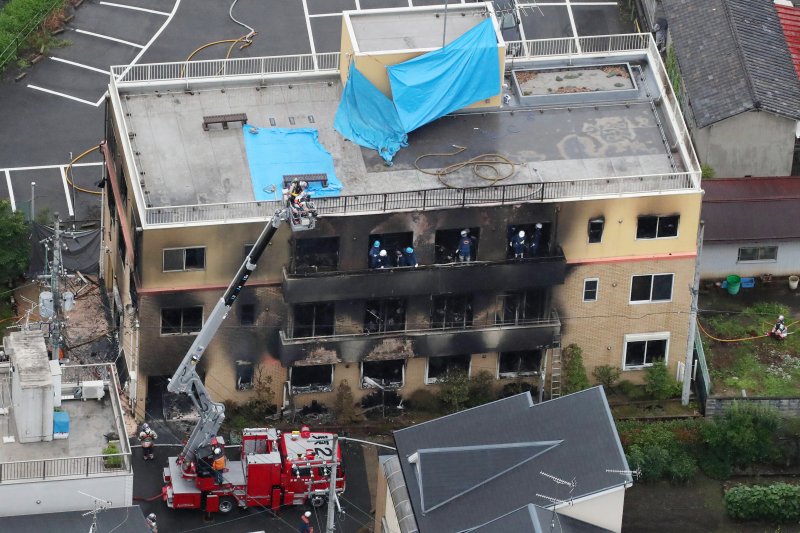Firefighters search for the missing Thursday at the Kyoto Animation in Kyoto, Japan. Photo by JIJI/EPA-EFE
TOKYO, July 19 (UPI) -- Japanese authorities have revealed new details about the fire that killed nearly three dozen people at an animation studio.
Police said a man armed with gasoline upset about a plagiarism issue set the Kyoto Animation headquarters ablaze Thursday, in the worst mass killing in Japan in two decades.
The fire killed 33, 19 of whom died of carbon monoxide poisoning as they scrambled up the stairs to the fire escape on the roof only to find the door locked, officials said. Investigators said suspect Shinji Aoba has confessed to starting the fire. He was treated for burns to his face and chest.
Witnesses said they heard him yell "die" before dousing the entrance with gasoline lighting the fire. Witnesses said a man resembling Aoba filled two gas cans at a station in the area.
Officials said the fire was finally extinguished nearly 24 hours after it started. There were 74 people working in the building when the fire started Thursday.
In Akihabara, Tokyo's best-known center of anime culture, the deadly attack cast a shadow over the neighborhood, a neon-lit hub of multi-level superstores selling a staggering variety of manga, anime DVDs, character models and collectible items.
Fans on Friday said that Kyoto Animation, known widely as KyoAni, stood out in the crowded animation field for its meticulous, painstaking productions and subtle stories in the genre known as "slice of life."
Rather than giant robots or fantasy realms, KyoAni series and films often centered around the trials and tribulations of adolescent life.
The studio, founded in 1981 by Yoko and Hideaki Hatta, employed more female directors and writers than most and series such as K-On! and Tamako Market featured schoolgirl protagonists. The critically acclaimed 2016 film A Silent Voice touched on sensitive themes in Japan including bullying and suicide.
KyoAni fostered a special bond for fans such as Reo Nagutomo, a 20-year-old student who had come to Akihabara to shop for anime collectibles on Friday afternoon.
Nagutomo said his favorite work from the studio was the series Sound! Euphonium, which is centered around a music club in a high school.
"I was in band in high school so I felt a connection," he said.
"When I saw the news on Twitter, I didn't know what to think," he said "It was extremely depressing and made Twitter hard to look at."
Another anime fan in Akihabara, Yukina Kanzaki, 18, said that KyoAni works such as her favorite series, Violet Evergarden, stood out from the typical animated fare.
"They have such beautiful images," she said. "And their stories are deep and really make you think."
Curtis and Lauren Sunley, anime lovers from the United States who were visiting Akihabara on Friday, said extraordinary care and attention to detail was evident in KyoAni productions and that the loss was hard to grasp.
"It just hurts so bad," said Curtis Sunley. "They're such a small studio and they lost such a significant amount of their staff. It's absolutely heartbreaking that they went into work that day thinking everything would be fine."
The company has 165 employees with an average age of just 33, according to its website, a rarity in an industry that has made it increasingly difficult for young animators to make a living.
Most major studios employ freelancers and pay per frame drawn, but KyoAni hires their animators full-time and pays them a salary, while providing training and support.
"They really treat their people well, which is a rarity in this industry," said Matt Schley, a Tokyo-based writer who covers Japanese animation. "The animation industry [in Japan] is having a lot of trouble because animators don't get paid enough, especially young animators. They can't make enough money to survive."
Schley said that the employment conditions at KyoAni have allowed it to produce extraordinary work with a signature style.
"They've earned acclaim for having excellent-quality, visually stunning animation," he said. "A lot of that comes down to the way that they've built up their house style, which has been possible because they keep people around and hire them in-house and nurture them."
On its website, Kyoto Animation says its strives to keep its company "humanitarian."
"We value people. Promoting the growth of people is equal to creating the brightness of works," the site says.
Fans in the rest of Japan and around the world continued to show their support for KyoAni on Friday.
In Kyoto, mourners started putting flowers and other belongings at a makeshift memorial on the street not long after the fire.
"It's hard to put into words how I feel," 27-year-old anime fan Yuichi Kumami told Japan Today. "They may not be able to produce the same kind of works again and it was my hope that there would be more memorable works in the future but that may be impossible now and that is very saddening."
A massive online outpouring of grief also continued, with hashtags such as "PrayForKyoAni," trending worldwide.
Houston-based Sentai Filmworks, which licenses and localizes Japanese content for wider distribution, started a GoFundMe campaign to help support the studio in the aftermath of the tragedy. As of Friday evening in Japan, more than 42,000 donors had raised in excess of $1.3 million.















